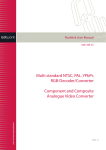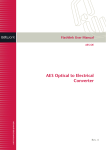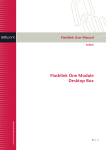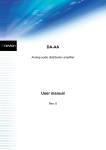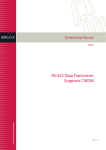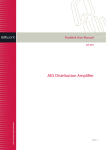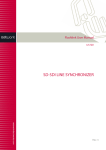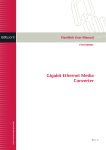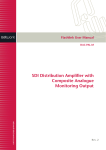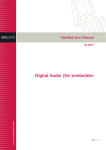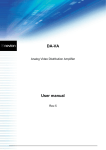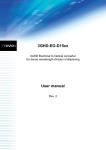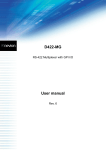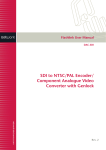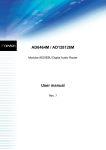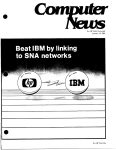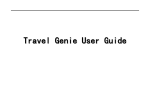Download ADC-SDI - Nevion
Transcript
Flashlink User Manual ADC-SDI NTSC/PAL to SDI encoder network-electronics.com Rev. 6 ADC-SDI Rev. 6 Network Electronics AS P.O. Box 1020 N-3204 Sandefjord, Norway Phone: +47 33 48 99 99 Fax: +47 33 48 99 98 Email: [email protected] www.network-electronics.com Support Phone: +47 90 60 99 99 Revision history Current revision of this document is the uppermost in the table below. Rev. 6 5 4 3 Repl. 5 4 3 2 Date 2008-07-14 2007-10-23 2007-10-09 2007-06-26 2 1 2005-07-07 1 0 2005-03-03 0 C 2004-01-20 C B A B A - 2003-01-28 2002-02-07 2001-12-01 Sign AS AS AS TØ Change description Added Declaration of Conformity. New front page. Added Materials Declaration and EFUP Corrected value for Return loss to ‘> 35 dB’ under specifications. Applied new document template, cleaned up document structure, added Appendix A Materials declaration and recycling information. New functionality added to DIP switch 9 (software release ≥ 7). Specification updated, and changed ConQuer to Flashlink. Updated with info about luma/chroma separation filter. Updated to ConQuer (software release 2). Changed section numbering. LED descriptions, and Flashlink commands. Preliminary revision for PIC software revision 0.1.2 network-electronics.com | 2 ADC-SDI Rev. 6 Contents 1 Product overview ..................................................................................................... 4 1.1 Quick Start Guides for ADC-SDI ........................................................................................4 2 Specifications .......................................................................................................... 5 2.1 Digital Serial Output ...........................................................................................................5 2.2 Analogue input, both PAL (625/50) and NTSC (525/60) ....................................................5 2.3 Processing performance ....................................................................................................5 2.4 Electrical.............................................................................................................................5 3 Configuration ........................................................................................................... 6 3.1 Data path............................................................................................................................6 3.2 EEPROM............................................................................................................................6 3.3 Power-up sequence ...........................................................................................................6 3.4 Channel search modes ......................................................................................................6 3.5 Luma / chroma separation filters ........................................................................................7 3.6 Selection of luma/chroma separation filter .........................................................................8 4 Connections............................................................................................................. 9 4.1 Mounting the connector module .........................................................................................9 4.2 Correspondence of connectors and signals .......................................................................9 5 Operation............................................................................................................... 11 5.1 Module status - Light Emitting Diodes..............................................................................11 5.2 Switches ...........................................................................................................................11 5.3 Interface with GYDA or other controllers..........................................................................14 General environmental requirements for Network Electronics equipment ................ 17 Product Warranty...................................................................................................... 18 Appendix A Materials declaration and recycling information..................................... 19 A.1 Materials declaration........................................................................................................19 A.2 Environmentally-friendly use period.................................................................................19 A.3 Recycling information.......................................................................................................20 EC Declaration of Conformity ................................................................................... 21 network-electronics.com | 3 ADC-SDI Rev. 6 1 Product overview Figure 1: Simplified block diagram of the ADC-SDI card The Flashlink ADC-SDI is a high-quality 10-bit NTSC/PAL composite 4:2:2 to digital video converter. ADC-SDI user parameters can be changed via switches on the unit, or via the GYDA control interface. To aid digital to analogue conversion of the digital output the ADC-SDI may generate a white pulse to mark first field of an 8-field-PAL/4-field-NTSC signal. If the digital to analogue converter is able to detect this, it will synchronize to the correct field (8-field-PAL/4-fieldNTSC) when synchronizing to an external Black & Burst-generator. The Flashlink DAC-SDI is able to do this. 1.1 Quick Start Guides for ADC-SDI 1.1.1 Without GYDA controller 1. Attach Analogue input (CVBS or S-Video) and SDI-output to the backplane module (see Figure 2). 2. Set DIP-switch 1 on (towards backplane), switches 2 and 3 according to the Input Channel search-mode you want (see Table 3). 3. Insert ADC-SDI into a slot in the sub-rack. 4. Power on. After some seconds the ADC-SDI should be running, and the input should be detected. No LED should be red and the SDI output should be active. If this is not the case, please see section 5.1. 1.1.2 With GYDA controller 1. Attach Analogue input (CVBS or S-Video) and SDI-output to the backplane module (see Figure 2). 2. Insert ADC-SDI into a slot in the sub-rack. 3. Power on. After some seconds the ADC-SDI should be running, and the input should be detected. No LED should be red and the SDI output should be active. The card settings should be as the previous time power was applied. 4. Communication with the card is described in section 5.3. network-electronics.com | 4 ADC-SDI Rev. 6 2 Specifications 2.1 Digital Serial Output Output format 270 Mb/s scrambled NRZI Output level 800 mV nominal Return loss > 15 dB 2.2 Analogue input, both PAL (625/50) and NTSC (525/60) Input formats CVBS S-Video Input level 1000 mV nominal ± 10 mV Return loss > 35 dB 2.3 Processing performance Signal path 10 bits Video processing delay 2 video lines 2.4 Electrical Input Voltage DC 5 V DC –15 V Power Consumption < 2.6 W network-electronics.com | 5 ADC-SDI Rev. 6 3 Configuration 3.1 Data path The Analogue input is identified, the synchronization information in the analogue signal is detected, and the analogue signal is digitized to a 10-bit parallel signal in a dedicated chip. A FPGA adds EDH-information and Field 1 marking. Finally a chip serializes and scrambles the signal, and drives the resulting 270 Mb/s SDI-signal onto three output connectors. 3.2 EEPROM The ADC-SDI card actually has two EEPROM's. A small EEPROM is included in the microcontroller, while a larger external EEPROM holds the configuration memory of the FPGA and the input video chip. 3.2.1 Internal EEPROM State variables are written to EEPROM in the microcontroller each time a configuration change is made. Basically, the card remembers it's setting between power-downs. 3.2.2 External EEPROM The configuration memory of the FPGA and the input video chip is upgradeable. This is, however, a task for qualified maintenance personnel. 3.3 Power-up sequence At power-up, the card performs a self-check, and initiation. The manual mode switch is then sampled. If manual mode is enabled, the other switch settings are read and the state of the card set accordingly. If manual mode is disabled, the state the card held the previous time it was used is read from EEPROM. The interplay between the EEPROM, the switches and the GYDA (or other) controller adheres to the following simple rules: − − − − If a GYDA controller is present in a system, it can always override manual settings. If the manual mode is used together with a GYDA controller, the ADC-SDI will initiate as determined by the switches, and may then be overridden by the controller. If the manual mode is not used, the ADC-SDI will initiate as determined by the state of the EEPROM. It is subsequently controlled by the GYDA controller. At any time, when a state change is done, whether it be by switches or GYDA, the state is stored in the EEPROM as soon as it is detected. 3.4 Channel search modes ADC-SDI will search for an input-signal, try to identify it and hopefully find a signal it can lock to. ADC-SDI has 2 input channels with 3 types of input: − − − CVBS Channel 1 CVBS Channel 2 S-Video: Luma Channel 1, Chroma Channel 2. network-electronics.com | 6 ADC-SDI Rev. 6 To search for input ADC-SDI has 4 channel search modes: − Automatic ADC-SDI searches for any possible input signal type. When a signal is detected, it tries to lock to it, and stops searching. − CVBS Ch. 1 ADC-SDI searches for CVBS input on channel 1, and ignores other input types. When a signal is detected, it tries to lock to it, and stops searching. − CVBS Ch. 2 ADC-SDI searches for CVBS input on channel 2, and ignores other input types. When a signal is detected, it tries to lock to it, and stops searching. − S-Video ADC-SDI searches for S-Video input, Luma on channel 1, chroma on channel 2, and ignores other input types. When a signal is detected, it tries to lock to it, and stops searching. If the input type is changed while the card is running, or the signal is missing or lost, the card will start searching for the type of signal defined by the channel search mode. Channel search mode settings are described in sections 6 and 7.3. 3.5 Luma / chroma separation filters The ADC-SDI module has 4 different luma / chroma separation filters to select between. 3.5.1 Comb filter - adaptive between 3-line (½, 0, ½) and no comb filter This filter will adaptively select between 3-line (½, 0, ½) comb filter and no comb filter. Adaptive comb filter is available for both luminance and chrominance. The adaptive comb filter algorithm computes the vertical and horizontal contours of colour based on a block of 3x3 pixels. If there is a sharp colour transition, comb filtering is applied to the two lines that have fewer colour changes. If there is no colour transition, 3-line comb filtering is used with filter coefficients (½, 0, ½). The comb filter can be selectively bypassed in luma or chroma path. If the comb filter is bypassed in the luma path, then chroma trap filters are used which has a characteristic according to CCIR601. The adaptive comb filter algorithm reduces artefacts such as hanging dots at colour boundary and detects and properly handles false colour in high frequency luminance images such as a multi burst pattern or circle pattern. 3.5.2 Comb filter - adaptive between 3-line (¼, ½, ¼) and no comb filter This filter will adaptively select between 3-line (¼, ½, ¼) comb filter and no comb filter, same functionality as the above, but with different filter coefficients. 3.5.3 Fixed 2-line comb filter This is a fixed 2-line comb filter with no adaptive selection. 3.5.4 No comb filter This filter has no comb filter enabled. The luma signal will be filtered with a chroma trap, and the chroma signal will be filtered with a low pass filter. network-electronics.com | 7 ADC-SDI Rev. 6 3.6 Selection of luma/chroma separation filter Filter type No comb filter (filter 3) Fixed 2-line comb filter (filter 2) Adaptive 3-line comb filter with filter coefficients (½,0,½) (filter 0 for PAL) (filter 1 for NTSC) Adaptive 3-line comb filter with filter coefficients (¼, ½, ¼) (filter 0 for NTSC) (filter 1 for PAL) Luma Bandwidth Limitations PAL ~= 4MHz Limited bandwidth. NTSC ~= 3MHz Cross colour artefacts visible in luma Full bandwidth Cross chroma errors at available vertical transitions. For PAL: Some cross colour artefacts in luma Full bandwidth available Some cross colour artefacts at vertical transition. Graphics material with high saturation may produce artefacts at vertical edges. Full bandwidth available Graphics material with high saturation may produce artefacts at vertical edges. Some Cross colour artefacts visible in luma for PAL signal sources. Applications VHS, Umatic and other sources with lower bandwidth Full bandwidth processing. Not suitable for graphics or material with high saturation levels. Best suited for PAL signal sources. Very good for most PAL applications. Best suited for NTSC signal sources. Very good for most NTSC applications. Also a good alternative for PAL sources if artefacts in (½, 0, ½) are unacceptable. Table 1: Selection of luma /chroma separation filter. The factory default filter setting is: Adaptive 3-line comb filter with filter coefficients (½,0,½). network-electronics.com | 8 ADC-SDI Rev. 6 4 Connections The ADC-SDI has its own connector module: ADC-SDI-C1, mounted at the rear of the subrack. Figure 2: ADC-SDI-C1 connector module. 4.1 Mounting the connector module If the connector module is purchased separately, it should be mounted as described in the user manual for the sub-rack frame FR-2RU-10-2. This manual is also available from our web site: http://www.network-electronics.com/ 4.2 Correspondence of connectors and signals The ADC-SDI-C1 connector module has 7 BNC's: Ch1 Ch2 Dup1 Dup2 SDI1 SDI2 SDI3 Analog input: CVBS or S-Video Luma Analog input: CVBS or S-Video Chroma Passive loop through Ch1. Passive loop through Ch2. Digital SDI output Digital SDI output Digital SDI output The analogue input BNC's can be used with CVBS, one at a time, or together with S-Video Luma on Ch1 and Chroma on Ch2. SDI1, SDI2 and SDI3 are equivalent SDI outputs. The backplane has a DIP-switch with two individual switches, as shown in Figure 2. Switch 1 is used to turn on/off 75 ohm termination on input channel 1, and switch 2 is used to turn on/off 75 ohm termination on input channel 2. The analogue input must be terminated somewhere to enable the video decoder chip. network-electronics.com | 9 ADC-SDI Rev. 6 Figure 3: ADC-SDI simplified silkscreen (figure not to scale). network-electronics.com | 10 ADC-SDI Rev. 6 5 Operation 5.1 Module status - Light Emitting Diodes Summary: Green LEDs are good, red LEDs are bad. ADC-SDI implements four Light Emitting Diodes (LEDs) that show the state of the card. The LEDs are visible through the front-panel of the rack (see the user manual of FR-2RU-10-2 for details). The LEDs are described top-down, see also Figure 3. 5.1.1 Card State No Light Red Yellow Green No power, fuse F1 blown, LED malfunction or configuration memory lost. A fundamental, probably electrical, error has been detected. The card is set in a passive state, so that it does not disturb other cards in the rack. While powering on, the CardState LED will light red for approximately 0.5 s while the card undergoes self-test. The startup-sequence is running. The card is not yet ready ADC-SDI is powered and ready. 5.1.2 State of input channel 1 No Light Red Yellow Green Channel 1 is inactive. ADC-SDI tries to detect input signal on channel 1. Input signal is detected on channel 1, but not yet locked. Input signal on channel 1 is detected, and properly locked. 5.1.3 State of input channel 2 No Light Red Yellow Green Channel 2 is inactive. ADC-SDI tries to detect input signal on channel 2. Input signal is detected on channel 2, but not yet locked. Input signal on channel 2 is detected, and properly locked. 5.1.4 SDI output No Light Red Yellow Green Not used. No SDI output, or SDI output not correct. Not used. Correct SDI output. 5.2 Switches Summary: Most users will probably want switches 1, 6 and 10 in on position and the rest in off position. All users should place switch 10 in the on position. The ADC-SDI card implements a Dual-Inline switch (DIP-switch) that provides 10 individual On/Off switches. The purpose of the switches is to offer you an easy interface to some features of the ADC-SDI card, without the need of a GYDA controller. Table 2 gives the general layout of the switches. The switches are numbered from '1' at the top and downwards to the bottom, see Figure 3. A switch is on when the tap is displaced in direction of the back-plane. The ADC-SDI card is shipped with all switches, except switch 1, 6 and 10, in the Off-position. Switch number 10 should always be in the On-position. The switches are discussed in logical rather than numerical order. network-electronics.com | 11 ADC-SDI Switch # 1 2 3 4 5 6 7 8 9 10 Rev. 6 Function Manual mode on/off Input Channel select 1 Input Channel select 2 EDH disable on/off Comment When on, enables switches 2, 3, 4, and 5 According to Table 3 According to Table 3 When on, the EDH will not be inserted into the SDI-output. Mark Field 1 disable on/off When on, the Mark Field 1-feature is not used. Luma/chroma separation filters According to Table 4 Luma/chroma separation filters According to Table 4 Factory Reset on/off To restore internal EEPROM only Chroma blanking for Teletext Chroma blanking for Teletext within vertical blanking area Running mode on/off For factory use only Table 2: Summary of the DIP switches. Switch 9 and 10 are mainly for factory use, while switches 1, 2, 3, 4, 5, 6 and 7 will be used when no GYDA controller is available. 5.2.1 Switch 1 - Manual mode Switch 1 is the manual mode switch. If set to on, the ADC-SDI is primarily assumed to be operated with switches alone. If set to off, the ADC-SDI is assumed to be used with a GYDA controller. Factory setting is switch 1 in off position. With switch 1 off While in automatic mode, switches 2, 3, 4 and 5 are without any effect. With switch 1 on In manual mode, the functionality of switches 2, 3, 4 and 5 is as follows: 5.2.2 Switches 2 and 3 These two switches determine the input channel selection. See Table 4. Factory setting is switch 2 and switch 3 off. Sw #3 0 0 1 1 Sw #2 0 1 0 1 Input Channel Select Automatic CVBS Ch. 1 CVBS Ch. 2 S-Video Comment Search for any possible input type. Only search for CVBS on Ch. 1 Only search for CVBS on Ch. 2 Only search for S-Video; Luma Ch. 1 and Chroma Ch. 2 Table 3: Manual selection of video mode 5.2.3 Switch 4 Switch 4 turns on/off disabling of EDH in the output SDI. With switch 4 off, the EDH is included in the SDI signal, with switch 4 on, EDH is not included. Factory setting is switch 4 in off position. 5.2.4 Switch 5 Switch 5 turns on/off disabling of the Mark Field 1-feature. With switch 5 off the Mark Field 1feature is enabled, with switch 5 on the Mark Field 1-feature is disabled. Factory setting is switch 5 in off position. network-electronics.com | 12 ADC-SDI Rev. 6 5.2.5 Switch 6 & 7 These two switches determine which Luma / Chroma separation filter that are in selected, according to Table 5. The factory settings are switch 6 set to on and switch 7 set to off. Function description Switch # 6 7 0 0 1 0 0 1 1 1 Default adaptive 3-line comb filter selection. NTSC adaptive comb with filter coefficients (¼, ½, ¼) PAL adaptive comb with filter coefficients (½, 0, ½) Adaptive 3-line comb filter selection with optional filter coefficients NTSC adaptive comb with filter coefficients (½, 0, ½) PAL adaptive comb with filter coefficients (¼, ½, ¼) Fixed 2-line comb filter No comb filter Luma filtered with chroma trap Chroma low pass filtered Table 4: Luma / Chroma separation filter. 5.2.6 Switch 8 - Reset to factory default ADC-SDI contains EEPROM that is affected by your choices. Switch 8 is implemented to reset the EEPROM to factory default. Its use is shown in Table 5. Action Power down Turn switch 8 on Power up Power down Turn switch 8 off Power up Comment ADC-SDI enters a special state where the EEPROM is restored to factory default values. This is flagged by the LEDs, they are all yellow. If you want the DIP switches to be placed in the factory default position, this is the time to do so: Turn switches 1 through 9 to the off position. Switch 10 should, as always, be turned to the on position. The card EEPROM is now reset to factory settings. Table 5: A method to restore the ADC-SDI card to the factory settings. Remember to let some seconds pass by each time you power down, to allow capacitors to be fully discharged. 5.2.7 Switch 9 –Chroma Blanking for Teletext Switch 9 is enabling Chroma Blanking within the vertical blanking area. When on, the chroma information in lines 1-23 / 313-335 (PAL) or 1-21 / 263-284 (NTSC) will be erased (replaced with 0x200). This is an important setting when using ADC-SDI with teletext information in line 23 (like for PAL+). When switch 9 is off, the vertical blanking area will be optimised for video information. When using ADC-SDI with S-Video (Y/C), it is recommended to leave switch 9 in off position Factory setting is switch 9 in off position. 5.2.8 Switch 10 - Programming mode Switch 10 is purely used for service upgrade of the ADC-SDI card. It should always be in the on position. If switch 10 is in the off position, the CardState LED will light up red, and the ADC-SDI card will enter programming mode. This causes no harm, but the card will not work in this mode. Factory setting is switch 10 in on position. network-electronics.com | 13 ADC-SDI Rev. 6 5.3 Interface with GYDA or other controllers ADC-SDI follows the Flashlink-protocol, see the definition of the protocol available from our web site: http://www.network-electronics.com/. ADC-SDI can also be used with any controller or controller system that adheres to the Flashlink-protocol, using the RS422 bus. For more information on the electrical interconnect, see the documentation of RS-2RU-10-2. The available commands are shown in Table 6. Command ? info AutoSearch CVBSCh1 CVBSCh2 SVideo EDH on EDH off MarkF1 on MarkF1 off get [0xHH] set [0xHH] [0xHH] filter 0 filter 1 filter 2 filter 3 Response Yes Yes “OK” “OK” “OK” “OK” “OK” “OK” “OK” “OK” Yes No “OK” “OK” “OK” “OK” Comment The “Hello” command. Gives back the card state. Set Cannel Search mode to automatic. Set Cannel Search mode to CVBS Ch. 1. Set Cannel Search mode to CVBS Ch. 2. Set Cannel Search mode to S-Video; Luma Ch1, Chroma Ch2. Turn on EDH in output SDI. Turn off EDH in output SDI. Turn on the Mark Field 1-feature. Turn off the Mark Field 1-feature. Get a value from a numbered register. Set a value to a numbered register. Select luma/ chroma separation filter, see Table 4. Select luma/ chroma separation filter, see Table 4. Select luma/ chroma separation filter, see Table 4. Select luma/ chroma separation filter, see Table 4. Table 6: All commands available to the user 5.3.1 The '?' command According to the Flashlink-protocol, no card can use the RS422-bus before the '?' (hello) command is sent the card at least once. The response from ADC-SDI will be: xxxxADC-SDI\ PIC sw rev X.X.X\ FPGA sw rev X\ Protocol ver X.X Here xxxx denotes the source and destination rack and slot coordinates, while X represents a version number. As of primo February 2002, these revisions would be: xxxxADC-SDI\ PIC sw rev 1.1.0\ FPGA sw rev 7\ Protocol ver 1.0 5.3.2 The “info” command This command reports the entire state of the card. An example: xxxxChannel Select: automatic\ Locked PAL CVBS Ch. 1 network-electronics.com | 14 ADC-SDI Rev. 6 The “info” command is composed by many minor lines, fully specified in Table 7. In general, when a condition is normal, it is not reported. For instance, EDH will normally be enabled. It is only when it is disabled its state is reported. 5.3.3 Channel Search commands The commands AutoSearch, CVBSCh1, CVBSCh2 and SVideo all determine the channel search mode of the card. The AutoSearch-command will let the ADC-SDI-card search for any possible input type: CVBS Ch. 1, CVBS Ch. 2 or S-Video with Luma on Ch. 1 and Chroma on Ch. 2. The other three commands will force the ADC-SDI-card to search for only one of the three input types. 5.3.4 EDH- and MarkF1-commands Commands to turn on/off the Mark Field 1-feature or the EDH inclusion in the SDI output are both straightforward text, see Table 6. 5.3.5 Get and Set These commands are factory internal. The end-user should avoid these commands. 5.3.6 Luma / Croma separation filter. Commands to select between different luma/chroma separation filters. network-electronics.com | 15 ADC-SDI Status of Channel Select Analog input and SDI output EDH Field 1 marking Filter 0 Filter 1 Filter 2 Filter 3 Rev. 6 Status string Channel Select: Automatic Comment Search for any legal type of input signal on the 2 input channels. Channel Select: Ch. 1 CVBS Search for CVBS Ch. 1 Channel Select: Ch. 2 CVBS Search for CVBS Ch. 2 Channel Select: S-Video Search for S-Video, Luma Ch. 1, Chroma Ch. 2 Searching for input on Ch1 and No input signal detected. Searching for any Ch2 legal type of input (Channel Select: Automatic). No SDI output. Searching for CVBS, Ch. 1 No input signal detected. Searching for CVBS, Ch. 1 (Channel Select: Ch. 1 CVBS). No SDI output. Searching for CVBS, Ch. 2 No input signal detected. Searching for CVBS, Ch. 2 (Channel Select: Ch. 2 CVBS). No SDI output. Searching for S-Video No input signal detected. Searching for SVideo Channel Select: S-Video). No SDI output. Try lock CVBS Ch. 1 CVBS found on Ch. 1, not yet locked. No SDI output. Try lock CVBS Ch. 2 CVBS found on Ch. 2, not yet locked. No SDI output. Try lock S-Video S-Video found, not yet locked. No SDI output. Locked <video standard> CVBS Stable locked CVBS on Ch. 1. SDI output is Ch. 1 on. Locked <video standard> CVBS Stable locked CVBS on Ch. 2. SDI output is Ch. 2 on. Locked <video standard> SStable locked S-Video input. SDI output is Video on. Valid video standards: NTSC, NTSC 4.43, PAL, (M) PAL and (Combination-N) PAL. EDH off No EDH information in SDI output. (No EDH status string) EDH information is included in SDI output. Field 1 marking off The Mark Field 1-feature is turned off (No Field 1 marking-string) Mark Field 1-feature is turned on No filter status string Luma / chroma separation filter 0 selected Filter mode 1 Luma / chroma separation filter 1 selected Filter mode 2 Luma / chroma separation filter 2 selected Filter mode 3 Luma / chroma separation filter 3 selected Table 7: The info command broken up in components. network-electronics.com | 16 ADC-SDI Rev. 6 General environmental requirements for Network Electronics equipment 1. 2. - The equipment will meet the guaranteed performance specification under the following environmental conditions: Operating room temperature range: 0°C to 40°C Operating relative humidity range: Up to 90% (non-condensing) The equipment will operate without damage under the following environmental conditions: Temperature range: -10°C to 50°C Relative humidity range: Up to 95% (non-condensing) network-electronics.com | 17 ADC-SDI Rev. 6 Product Warranty The warranty terms and conditions for the product(s) covered by this manual follow the General Sales Conditions by Network Electronics AS. These conditions are available on the company web site of Network Electronics AS: www.network-electronics.com network-electronics.com | 18 ADC-SDI Rev. 6 Appendix A Materials declaration and recycling information A.1 Materials declaration For product sold into China after 1st March 2007, we comply with the “Administrative Measure on the Control of Pollution by Electronic Information Products”. In the first stage of this legislation, content of six hazardous materials has to be declared. The table below shows the required information. Toxic or hazardous substances and elements 組成名稱 Part Name ADC-SDI 鉛 汞 镉 六价铬 多溴联苯 多溴二苯醚 Lead Mercury Cadmium Hexavalent Polybrominated Polybrominated Chromium biphenyls diphenyl ethers (Pb) (Hg) (Cd) (Cr(VI)) (PBB) (PBDE) X O O O O O O: Indicates that this toxic or hazardous substance contained in all of the homogeneous materials for this part is below the limit requirement in SJ/T11363-2006. X: Indicates that this toxic or hazardous substance contained in at least one of the homogeneous materials used for this part is above the limit requirement in SJ/T11363-2006. A.2 Environmentally-friendly use period The manual must include a statement of the “environmentally friendly use period”. This is defined as the period of normal use before any hazardous material is released to the environment. The guidance on how the EFUP is to be calculated is not finalised at the time of writing. See http://www.aeanet.org/GovernmentAffairs/qfLeOpAaZXaMxqGjSFbEidSdPNtpT.pdf for an unofficial translation of the draft guidance. For our own products, Network Electronics has chosen to use the 50 year figure recommended in this draft regulation. Network Electronics suggests the following statement on An “Environmentally Friendly Use Period” (EFUP) setting out normal use: EFUP is the time the product can be used in normal service life without leaking the hazardous materials. We expect the normal use environment to be in an equipment room at controlled temperature range (0ºC - 40ºC) with moderate humidity (< 90%, non-condensing) and clean air, not subject to vibration or shock. Further, a statement on any hazardous material content, for instance, for a product that uses some tin/lead solders: Where a product contains potentially hazardous materials, this is indicated on the product by the appropriate symbol containing the EFUP. The hazardous material content is limited to lead (Pb) in some solders. This is extremely stable in normal use and the EFUP is taken as 50 years, by comparison with the EFUP given for Digital Exchange/Switching Platform in equipment in Appendix A of “General Rule of Environment-Friendly Use Period of Electronic Information Products”. This is indicated by the product marking: 50 It is assumed that while the product is in normal use, any batteries associated with real-time clocks or battery-backed RAM will be replaced at the regular intervals. The EFUP relates only to the environmental impact of the product in normal use, it does not imply that the product will continue to be supported for 50 years. network-electronics.com | 19 ADC-SDI Rev. 6 A.3 Recycling information Network Electronics provides assistance to customers and recyclers through our web site http://www.network-electronics.com. Please contact Network Electronics’ Customer Support for assistance with recycling if this site does not show the information you require. Where it is not possible to return the product to Network Electronics or its agents for recycling, the following general information may be of assistance: − − − − Before attempting disassembly, ensure the product is completely disconnected from power and signal connections. All major parts are marked or labelled to show their material content. Depending on the date of manufacture, this product may contain lead in solder. Some circuit boards may contain battery-backed memory devices. network-electronics.com | 20 ADC-SDI Rev. 6 EC Declaration of Conformity MANUFACTURER Network Electronics AS P.B. 1020, N-3204 SANDEFJORD, Norway AUTHORISED REPRESENTATIVE (Established within the EEA) Not applicable MODEL NUMBER(S) ADC-SDI DESCRIPTION NTSC/PAL to SDI encoder DIRECTIVES this equipment complies with LVD 73/23/EEC EMC 2004/108/EEC HARMONISED STANDARDS applied in order to verify compliance with Directive(s) EN 55103-1:1996 EN 55103-2:1996 TEST REPORTS ISSUED BY Notified/Competent Body Report no: Nemko E07379.00 TECHNICAL CONSTRUCTION FILE NO Not applicable YEAR WHICH THE CE-MARK WAS AFFIXED 2008 TEST AUTHORIZED SIGNATORY MANUFACTURER AUTHORISED REPRESENTATIVE (Established within EEA) Date of Issue 2008-07-14 Place of Issue Not applicable Name Thomas Øhrbom Position Quality Manager (authorised signature) Sandefjord, Norway network-electronics.com | 21





















